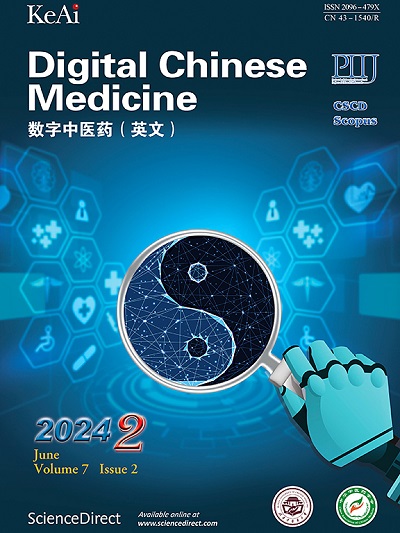Metabolic characteristics of Qi-Yin deficiency and heat stagnation in liver meridian patterns of dry eye based on tear metabolomics
Q3 Medicine
引用次数: 0
Abstract
Objective
To explore the metabolic differences between dry eye patients with Qi-Yin deficiency and heat stagnation in liver meridian patterns, and clarify their metabolic characteristics.
Methods
Patients with dry eye who were treated in the Ophthalmology Ward and Outpatient Department of the First Hospital of Hunan University of Chinese Medicine from October 1, 2020, to October 30, 2021 were enrolled as the research participants in the study. They were assigned to two groups based on traditional Chinese medicine (TCM) syndrome types: heat stagnation in liver meridian pattern group and Qi-Yin deficiency pattern group. Healthy volunteers who underwent health check-ups in the Health Management Department were included as healthy group following the random number table method. The tears of the patients and the healthy volunteer participants were tested by high-performance liquid chromatography-mass spectrometry (LC-MS). The differential metabolites were screened out by multivariate statistical analysis, and Kyoto Encyclopedia of Genes and Genomes (KEGG) pathway enrichment was performed on the differential metabolites. Finally, the association analysis of differential proteins and metabolites was conducted to verify and supplement the metabolites.
Results
A total of 32 dry eye patients were enrolled, including 16 cases with heat stagnation in liver meridian pattern and 16 cases with Qi-Yin deficiency pattern. Fourteen healthy volunteers were included as healthy group. There were no significant differences in baseline characteristics among the three groups (P > 0.05). A total of 412 biomarkers were determined in Qi-Yin deficiency pattern group, mainly including lipids, lipid-like molecules, organic acids and their derivatives, organic heterocyclic compounds, and nucleosides and their analogues. For heat stagnation in liver meridian pattern group, 112 metabolites were determined, mainly including organic acids and their derivatives, lipids, and lipid-like molecules. The KEGG enrichment results of pathways and the relative content analysis of differential markers demonstrate that purine metabolism and caffeine metabolism pathways are common metabolic characteristics of all dry eyes. Among them, deoxyinosine monophosphate (dIMP) and 2-(formamido)-N1-(5-phospha-D-ribosyl) acetamidine can serve as their biomarkers. The main characteristics of Qi-Yin deficiency syndrome pattern were the significant enhancement of metabolic pathways such as lysine degradation, ovarian steroidogenesis, cholesterol metabolism, pyrimidine metabolism, and bile secretion (P < 0.05). Dry eye associated with the heat stagnation in liver meridian pattern is mainly characterized by inhibition of the valine, leucine, and isoleucine biosynthesis pathways (P < 0.05).
Conclusion
Metabolomics can be used as an effective basis for TCM syndrome classification. Different patterns of dry eye syndrome exhibit typical characteristics in the types and concentrations of metabolites, which correspond to the syndrome classification in TCM. This study initially confirms the rationality of TCM syndrome classification and provides significant reference for the mechanism of dry eye and drug development.
基于泪液代谢组学的干眼症肝经络气阴虚热郁的代谢特征
目的探讨气阴虚热滞型干眼症肝经证的代谢差异,阐明其代谢特点。方法选取2020年10月1日至2021年10月30日在湖南中医药大学第一医院眼科病房和门诊部就诊的干眼症患者作为研究对象。根据中医证型分为肝经热郁证组和气阴虚证组。采用随机数字表法将在健康管理部门进行健康检查的健康志愿者作为健康组。采用高效液相色谱-质谱联用技术(LC-MS)检测患者和健康志愿者的眼泪。通过多元统计分析筛选出差异代谢物,并对差异代谢物进行京都基因与基因组百科全书(KEGG)途径富集。最后进行差异蛋白与代谢物的关联分析,对代谢物进行验证和补充。结果共纳入32例干眼症患者,其中肝经热滞型16例,气阴虚型16例。选取14名健康志愿者作为健康组。三组患者的基线特征无显著差异(P >;0.05)。气阴虚证组共检测到412种生物标志物,主要包括脂类、类脂类分子、有机酸及其衍生物、有机杂环化合物、核苷及其类似物等。肝经证热郁组测定代谢产物112种,主要包括有机酸及其衍生物、脂类及类脂类分子。通路的KEGG富集结果和差异标记物的相对含量分析表明,嘌呤代谢和咖啡因代谢通路是所有干眼症的共同代谢特征。其中,单磷酸脱氧肌苷(dIMP)和2-(甲胺)- n1 -(5-磷酸- d -核糖基)acetamidine可作为它们的生物标志物。气阴虚证型的主要特点是赖氨酸降解、卵巢类固醇生成、胆固醇代谢、嘧啶代谢、胆汁分泌等代谢途径明显增强(P <;0.05)。肝经络热滞干眼主要表现为缬氨酸、亮氨酸和异亮氨酸生物合成途径的抑制(P <;0.05)。结论代谢组学可作为中医证候分型的有效依据。干眼症不同证型在代谢物类型和浓度上表现出典型特征,与中医辨证分型相对应。本研究初步证实了中医辨证分型的合理性,为干眼症的发病机制及药物研发提供了重要参考。
本文章由计算机程序翻译,如有差异,请以英文原文为准。
求助全文
约1分钟内获得全文
求助全文
来源期刊

Digital Chinese Medicine
Medicine-Complementary and Alternative Medicine
CiteScore
1.80
自引率
0.00%
发文量
126
审稿时长
63 days
期刊介绍:
 求助内容:
求助内容: 应助结果提醒方式:
应助结果提醒方式:


